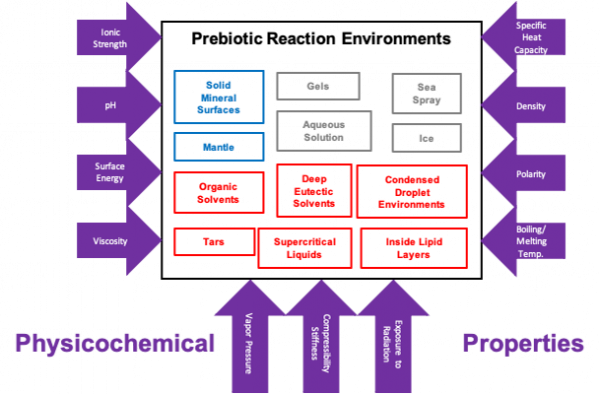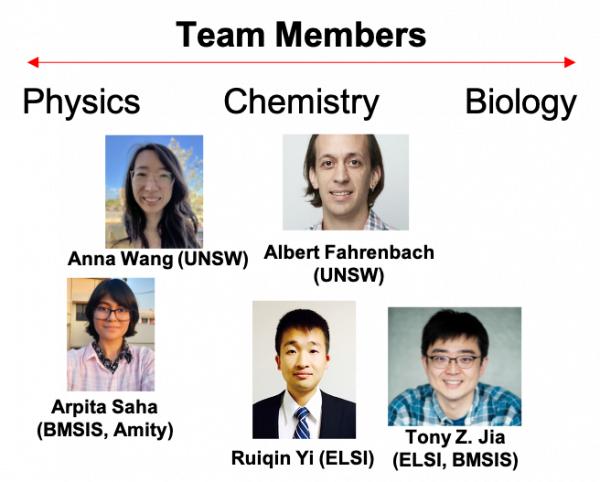There were many potential reaction microenvironments on early Earth, from aqueous solutions to mineral surfaces, from aerosols to condensed phase droplets. However, each of these environments is entirely different in its physicochemical properties, resulting in different reactions being favoured in each environment. In this paper, the team of researchers, including scientists of ELSI, consider how different physicochemical properties of prebiotic microenvironments could have been relevant on early Earth and also how these properties can affect prebiotic chemistries.

The origin of life required prebiotic chemical reactions to generate the first molecules of life and for these molecules to react and self-assemble into primitive assemblies capable of evolving into modern cells and biochemistries. However, the putative locations for the key chemical reactions on Earth are still an active area of research. For example, it is possible for some reactions to have occurred in aqueous solutions, such as in primitive bodies of water, and others to have occurred on mineral surfaces on early Earth or in supercritical liquids found at the bottom of the ocean.
While no one rewind time to see what reactions occurred in which environments, researchers can start to create a map of how environments differed from each other and how these differences and similarities manifest themselves in the potential prebiotic chemical repertoire.
Here, the authors sought to analyse these different primitive reaction microenvironments by comparing various physicochemical properties, including viscosity, polarity, ionic strength, and material and mechanical properties such as stiffness or heat capacity. Understanding the basics of the physicochemical properties of reaction environments will not only help scope out which primitive reactions would have been plausible in which primitive environments (giving us more clues into the origins of life), but would also help to inform experimental design of future prebiotic chemistry experiments.
The authors start by describing a number of different available reaction microenvironments on primitive Earth (they did not focus on extraterrestrial environments), categorising these into aqueous, non-aqueous, and mineral/rock-related environments, totalling 12 different environments. This discussion also includes the prebiotic relevance of each environment. The authors then present 11 different physicochemical properties and start by describing the nature and basics of each property. For most of the physicochemical properties, one or two ways to measure the said property are also introduced; for example, a way to quantify polarity is through relative permittivity (ε), while Bulk (K) and Young’s (E) modulus can be used to quantify different measures of stiffness. Each of these properties is then reported in table form for as many of the primitive environments as possible. Indeed, some of these are still yet to be measured. The authors challenge the origins of life research field to contribute and fill in the “missing values” together.
By analysing a table for each property, the researchers saw clear differences between different microenvironments and, conversely, a wide range of environments for each desired property. This method of physicochemical analysis will hopefully help future prebiotic chemists understand which reaction environments could have been physically plausible for prebiotic chemical reactions of their interest (while considering their geological plausibility). “We hope that by aggregating all of this disparate data gathered from papers in different fields, including not only prebiotic chemistry but also engineering and geology, the origins of life research community can use this as a resource for experimental design, while also informing us about the plausibility of certain reactions in certain environments,”, says co-corresponding author Tony Z. Jia, who is a Specially Appointed Assistant Professor at ELSI.
Finally, to fully understand physico–chemical properties, it was necessary to gather researchers with knowledge, especially in physics and chemistry. Thus, this study was performed in collaboration with a number of researchers around the world with different expertise, ranging from physics to biology. The authors hope to involve researchers from even more fields in the future, including (but not limited to) geologists and planetary scientists, in hopes of expanding this analysis to extraterrestrial microenvironments as well.

| Journal | Life |
| Title of the paper | A physicochemical consideration of prebiotic microenvironments for self-assembly and prebiotic chemistry |
| Authors | Arpita Saha1,2, Ruiqin Yi3, Albert C. Fahrenbach4,5,6, Anna Wang4,5,6*, Tony Z. Jia1,3,* |
| Affiliations | 1. Blue Marble Space Institute of Science, 600 1st Ave, Floor 1, Seattle, WA 98104, USA 2. Amity Institute of Applied Sciences, Amity University, Kolkata, 700135, India 3. Earth-Life Science Institute, Tokyo Institute of Technology, 2-12-1-IE-1 Ookayama, Meguro-ku, Tokyo 152-8550, Japan 4. School of Chemistry, UNSW Sydney, Bedegal Country, New South Wales 2052, Australia 5. Australian Centre for Astrobiology, UNSW Sydney, Bedegal Country, New South Wales 2052, Australia 6. UNSW RNA Institute, UNSW Sydney, Bedegal Country, New South Wales 2052, Australia |
| DOI | 10.3390/life12101595 |
| Online published date | 13 October 2022 |
